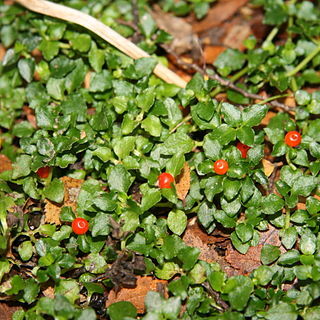Fls 4-5-merous, perfect, solitary, axillary or terminal, sessile or very shortly stalked. Calyx truncate, sts very obscurely toothed; corolla-tube funnelform, lobes valvate; Stamens inserted at base of tube; filaments filiform, far-exserted; anthers large, us. pend.; styles 2, filiform, hairy. Ovary 2-celled, ovules 1 per cell; drupe fleshy, rarely dry; pyrenes 2. Slender, creeping, branching, slightly foetid perennial herbs, rooting at nodes, with opp. lvs and small interpetiolar stipules. Genus of some 15 spp., of Australia, N.Z., Malaya, Central and South America, Tristan d'Acunha.
minute, axillary, sessile, usually perfect; calyx truncate or tubular, the teeth 4-5; corolla tubular or funnel shaped, glabrous within, the lobes 4, valvate; stamens 4, attached basally to the corolla, the anthers apiculate, exserted; ovary 2-celled, the style long exserted, hairy, the ovules solitary, erect from the base of the cell. Fruits rotund, succulent, red, with 2 cartilaginous nutlets.
Creeping, perennial herbs, often forming mats. Leaves small, often subsessile; stipules minute, adnate to the petioles, the sheath entire or with 2 teeth. Flowers

